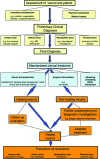Evidence-based management strategies for treatment of chronic wounds
- PMID: 19578487
- PMCID: PMC2691645
Evidence-based management strategies for treatment of chronic wounds
Abstract
The care and management of patients with chronic wounds and their far-reaching effects challenge both the patient and the practitioner. Further complicating this situation is the paucity of evidence-based treatment strategies for chronic wound care. After searching both MEDLINE and Cochrane databases, we reviewed currently available articles concerning chronic wound care. Utilizing this information, we have outlined a review of current, evidence-based concepts as they pertain to the treatment of chronic wounds, focusing on fundamental treatment principles for the management of venous, arterial, diabetic, and pressure ulcers. Individualized treatment options as well as general wound management principles applicable to all varieties of chronic wounds are described. Classification and treatment guidelines as well as the adoption of the TIME acronym facilitate an organized conceptional approach to wound care. In so doing, individual aspects of generalized wound care such as debridement, infection, and moisture control as well as attention to the qualities of the wound edge are comprehensively evaluated, communicated, and addressed. Effective adjuvant agents for the therapy of chronic wounds including nutritional and social support measures are listed, as is a brief review of strategies helpful for preventing recurrence. An appreciation of evidence-based treatment pathways and an understanding of the pathophysiology of chronic wounds are important elements in the management of patients with chronic wounds. To achieve effective and long-lasting results, a multidisciplinary approach to patient care, focused on the education and coordination of patient, family as well as medical and support staff can prove invaluable.
Figures
References
-
- Martin GM. Frontiers of aging. Science. 2001;294:13. - PubMed
-
- Strausberg J, Lehmann N, Kröger K, Maier I, Schneider H, Niebel W. Changes in secondary care may explain increasing pressure ulcer rates in an University Clinic in Germany. Wound Management. 2007;5:194–8.
-
- German National Healthservice. Report of the year. 2007
-
- Mustoe TA, O'Shaughnessy K, Kloeters O. Chronic wound pathogenesis and current treatment strategies: a unifying hypothesis. J Plast Reconstr Surg. 2006;117:35–41. - PubMed
-
- Wound Healing Society. Guidelines for the best care of chronic wounds. Wound Repair Regen. 2006;14:647–710. - PubMed
LinkOut - more resources
Full Text Sources
Other Literature Sources

